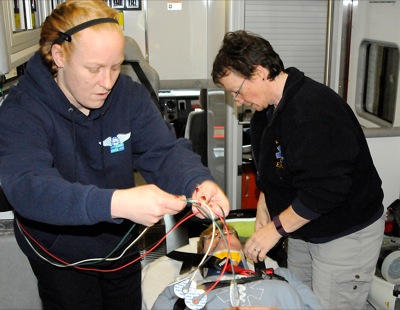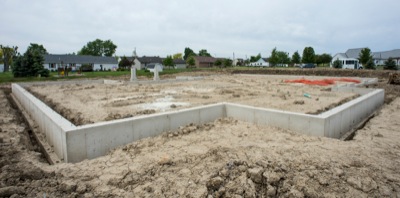Saturday, May 21st, 2016
EMS projects supported
Simulator to make training more realistic
By William Kincaid

Photo by William Kincaid/The Daily Standard
Rockford EMS volunteers Bre Shellabarger, left, and Lisa Faust practice a squad run. Mercer County EMS will soon receive a donated ambulance box, similar to the one shown here, to use as a simulator to train emergency medical technicians.
EDITOR'S NOTE: In recognition of Emergency Medical Services Week, the newspaper is publishing a multipart series on local EMS providers. This is the final story of the series.
Mercer County EMS will soon receive a donated ambulance box to train emergency medical technicians before throwing them into the chaos of their first squad run.
Also, experienced medical providers will advance their skills by practicing within a proposed patient simulator lab.
EMS coordinator Matt Nietfeld said Horton Emergency Vehicles of Grove City made a substantial donation to the agency by offering the ambulance box. The box, after additional upgrades, is slated for delivery this summer.
In the meantime, the county EMS continues to raise funds so it can build a 1,200-square-foot addition onto the northwest corner of its Riley Street office in Celina to house the box and train responders and technicians.
"The building plans are in the final stages with Fanning and Howey," said Rockford EMS member Lisa Faust, who is spearheading the project. "The projected total is $140,000 - $16,500 has been raised as of this date."
The county EMS, which has offered EMT training since 2014, aims to incorporate the patient simulator for hands-on training.
"This pa-tient simulator lab will be one of the only ones in the nation located in a rural, mostly volunteer-based EMS community," Faust said. "A patient simulator lab will allow us to do hands-on training during our initial EMT training classes as well as during continuing education training for our current EMTs. This lab will provide real-world experience that you cannot gain from sitting in a classroom."
Students and veterans in a controlled, realistic setting will learn about decision-making, scene management, crew coordination and communication, and transport operations, Faust noted.
"We're trying to create an environment that's as similar to a real EMS call as possible, and that's the flashing lights, the sirens, the darkness, the extremes in temperature, screams and yelling," said Dr. Craig Dues, an emergency physician at Mercer County Community Hospital in Coldwater. "All of those affect an EMS provider one way or another."
EMS providers don't have time to think - they must act resolutely on instinct, Dues said. Training should be engrained.
"You cannot accurately replicate a true emergency situation on a written exam whereas the simulation lab will give the instructors the ability to create patient scenarios and clinical decision-making that wouldn't otherwise be able to be done," he continued.
Moreover, officials plan to reach out to high school students by opening up a window to the day-to-day operations of the medical profession.
"The development of this simulator lab will positively affect all of the EMTs serving in Mercer County and in turn, will ensure that the population we serve will continue to be provided with the best possible emergency medical care," Faust said.
Tax-deductible donations can be made to the Mercer County Civic Foundation, to the attention of EMS patient simulator lab.


